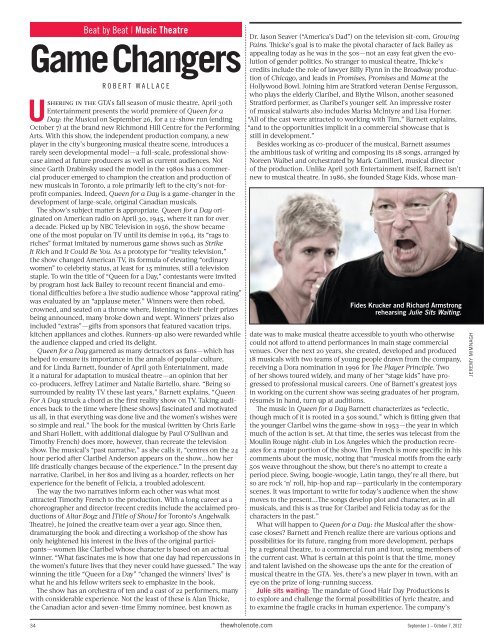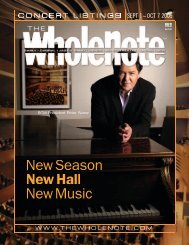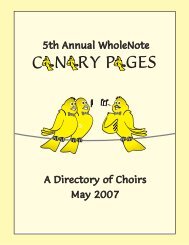PDF Version
PDF Version
PDF Version
- No tags were found...
You also want an ePaper? Increase the reach of your titles
YUMPU automatically turns print PDFs into web optimized ePapers that Google loves.
Beat by Beat | Music TheatreGame ChangersROBERT WALLACEUshering in the GTA’s fall season of music theatre, April 30thEntertainment presents the world premiere of Queen for aDay: the Musical on September 26, for a 12-show run (endingOctober 7) at the brand new Richmond Hill Centre for the PerformingArts. With this show, the independent production company, a newplayer in the city’s burgeoning musical theatre scene, introduces ararely seen developmental model — a full-scale, professional showcaseaimed at future producers as well as current audiences. Notsince Garth Drabinsky used the model in the 1980s has a commercialproducer emerged to champion the creation and production ofnew musicals in Toronto, a role primarily left to the city’s not-forprofitcompanies. Indeed, Queen for a Day is a game-changer in thedevelopment of large-scale, original Canadian musicals.The show’s subject matter is appropriate. Queen for a Day originatedon American radio on April 30, 1945, where it ran for overa decade. Picked up by NBC Television in 1956, the show becameone of the most popular on TV until its demise in 1964, its “rags toriches” format imitated by numerous game shows such as StrikeIt Rich and It Could Be You. As a prototype for “reality television,”the show changed American TV, its formula of elevating “ordinarywomen” to celebrity status, at least for 15 minutes, still a televisionstaple. To win the title of “Queen for a Day,” contestants were invitedby program host Jack Bailey to recount recent financial and emotionaldifficulties before a live studio audience whose “approval rating”was evaluated by an “applause meter.” Winners were then robed,crowned, and seated on a throne where, listening to their their prizesbeing announced, many broke down and wept. Winners’ prizes alsoincluded “extras”— gifts from sponsors that featured vacation trips,kitchen appliances and clothes. Runners-up also were rewarded whilethe audience clapped and cried its delight.Queen for a Day garnered as many detractors as fans — which hashelped to ensure its importance in the annals of popular culture,and for Linda Barnett, founder of April 30th Entertainment, madeit a natural for adaptation to musical theatre — an opinion that herco-producers, Jeffrey Latimer and Natalie Bartello, share. “Being sosurrounded by reality TV these last years,” Barnett explains, “QueenFor A Day struck a chord as the first reality show on TV. Taking audiencesback to the time where [these shows] fascinated and motivatedus all, in that everything was done live and the women’s wishes wereso simple and real.” The book for the musical (written by Chris Earleand Shari Hollett, with additional dialogue by Paul O’Sullivan andTimothy French) does more, however, than recreate the televisionshow. The musical’s “past narrative,” as she calls it, “centres on the 24hour period after Claribel Anderson appears on the show ... how herlife drastically changes because of the experience.” In the present daynarrative, Claribel, in her 80s and living as a hoarder, reflects on herexperience for the benefit of Felicia, a troubled adolescent.The way the two narratives inform each other was what mostattracted Timothy French to the production. With a long career as achoreographer and director (recent credits include the acclaimed productionsof Altar Boyz and [Title of Show] for Toronto’s AngelwalkTheatre), he joined the creative team over a year ago. Since then,dramaturging the book and directing a workshop of the show hasonly heightened his interest in the lives of the original participants— women like Claribel whose character is based on an actualwinner. “What fascinates me is how that one day had repercussions inthe women’s future lives that they never could have guessed.” The waywinning the title “Queen for a Day” “changed the winners’ lives” iswhat he and his fellow writers seek to emphasize in the book.The show has an orchestra of ten and a cast of 22 performers, manywith considerable experience. Not the least of these is Alan Thicke,the Canadian actor and seven-time Emmy nominee, best known asFides Krucker and Richard Armstrongrehearsing Julie Sits Waiting.Dr. Jason Seaver (“America’s Dad”) on the television sit-com, GrowingPains. Thicke’s goal is to make the pivotal character of Jack Bailey asappealing today as he was in the 50s — not an easy feat given the evolutionof gender politics. No stranger to musical theatre, Thicke’scredits include the role of lawyer Billy Flynn in the Broadway productionof Chicago, and leads in Promises, Promises and Mame at theHollywood Bowl. Joining him are Stratford veteran Denise Fergusson,who plays the elderly Claribel, and Blythe Wilson, another seasonedStratford performer, as Claribel’s younger self. An impressive rosterof musical stalwarts also includes Marisa McIntyre and Lisa Horner.“All of the cast were attracted to working with Tim,” Barnett explains,“and to the opportunities implicit in a commercial showcase that isstill in development.”Besides working as co-producer of the musical, Barnett assumesthe ambitious task of writing and composing its 18 songs, arranged byNoreen Waibel and orchestrated by Mark Camilleri, musical directorof the production. Unlike April 30th Entertainment itself, Barnett isn’tnew to musical theatre. In 1986, she founded Stage Kids, whose mandatewas to make musical theatre accessible to youth who otherwisecould not afford to attend performances in main stage commercialvenues. Over the next 20 years, she created, developed and produced18 musicals with two teams of young people drawn from the company,receiving a Dora nomination in 1996 for The Player Principle. Twoof her shows toured widely, and many of her “stage kids” have progressedto professional musical careers. One of Barnett’s greatest joysin working on the current show was seeing graduates of her program,résumés in hand, turn up at auditions.The music in Queen for a Day Barnett characterizes as “eclectic,though much of it is rooted in a 50s sound,” which is fitting given thatthe younger Claribel wins the game-show in 1953 — the year in whichmuch of the action is set. At that time, the series was telecast from theMoulin Rouge night-club in Los Angeles which the production recreatesfor a major portion of the show. Tim French is more specific in hiscomments about the music, noting that “musical motifs from the early50s weave throughout the show, but there’s no attempt to create aperiod piece. Swing, boogie-woogie, Latin tango, they’re all there, butso are rock ‘n’ roll, hip-hop and rap — particularly in the contemporaryscenes. It was important to write for today’s audience when the showmoves to the present ... The songs develop plot and character, as in allmusicals, and this is as true for Claribel and Felicia today as for thecharacters in the past.”What will happen to Queen for a Day: the Musical after the showcasecloses? Barnett and French realize there are various options andpossibilities for its future, ranging from more development, perhapsby a regional theatre, to a commercial run and tour, using members ofthe current cast. What is certain at this point is that the time, moneyand talent lavished on the showcase ups the ante for the creation ofmusical theatre in the GTA. Yes, there’s a new player in town, with aneye on the prize of long-running success.Julie sits waiting: The mandate of Good Hair Day Productions isto explore and challenge the formal possibilities of lyric theatre, andto examine the fragile cracks in human experience. The company’sJEREMY MIMNAGH34 thewholenote.com September 1 – October 7, 2012
















